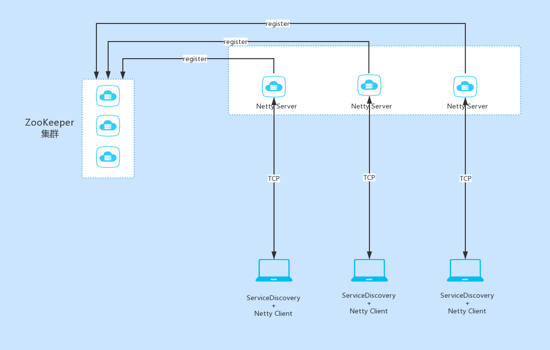жӮЁеҘҪпјҢзҷ»еҪ•еҗҺжүҚиғҪдёӢи®ўеҚ•е“ҰпјҒ
жӮЁеҘҪпјҢзҷ»еҪ•еҗҺжүҚиғҪдёӢи®ўеҚ•е“ҰпјҒ
иҝҷзҜҮж–Үз« е°ҶдёәеӨ§е®¶иҜҰз»Ҷи®Іи§Јжңүе…іNetty + ZooKeeperеҰӮдҪ•е®һзҺ°з®ҖеҚ•зҡ„жңҚеҠЎжіЁеҶҢдёҺеҸ‘зҺ°пјҢе°Ҹзј–и§үеҫ—жҢәе®һз”Ёзҡ„пјҢеӣ жӯӨеҲҶдә«з»ҷеӨ§е®¶еҒҡдёӘеҸӮиҖғпјҢеёҢжңӣеӨ§е®¶йҳ…иҜ»е®ҢиҝҷзҜҮж–Үз« еҗҺеҸҜд»ҘжңүжүҖ收иҺ·гҖӮ
дёҖ. иғҢжҷҜ
жңҖиҝ‘зҡ„дёҖдёӘйЎ№зӣ®пјҡжҲ‘们зҡ„зі»з»ҹжҺҘ收еҲ°дёҠжёёзі»з»ҹзҡ„жҙҫеҚ•д»»еҠЎеҗҺпјҢдјҡжҺЁйҖҒеҲ°жҢҮе®ҡзҡ„й—Ёеә—зҡ„зӣёе…іи®ҫеӨҮпјҢ并иҝӣиЎҢзӣёеә”зҡ„дёҡеҠЎеӨ„зҗҶгҖӮ
дәҢ. Netty зҡ„дҪҝз”Ё
еңЁжҺҘ收еҲ°жҙҫеҚ•д»»еҠЎд№ӢеҗҺпјҢйҖҡиҝҮ Netty жҺЁйҖҒеҲ°жҢҮе®ҡй—Ёеә—зӣёе…ізҡ„и®ҫеӨҮгҖӮеңЁжҲ‘们зҡ„зі»з»ҹдёӯ Netty е®һзҺ°дәҶж¶ҲжҒҜжҺЁйҖҒгҖҒй•ҝиҝһжҺҘд»ҘеҸҠеҝғи·іжңәеҲ¶гҖӮ

2.1 Netty Server з«Ҝ:
жҜҸдёӘ Netty жңҚеҠЎз«ҜйҖҡиҝҮ ConcurrentHashMap дҝқеӯҳдәҶе®ўжҲ·з«Ҝзҡ„ clientId д»ҘеҸҠе®ғиҝһжҺҘзҡ„ SocketChannelгҖӮ
жңҚеҠЎеҷЁз«Ҝеҗ‘е®ўжҲ·з«ҜеҸ‘йҖҒж¶ҲжҒҜж—¶пјҢеҸӘиҰҒиҺ·еҸ– clientId еҜ№еә”зҡ„ SocketChannelпјҢеҫҖ SocketChannel йҮҢеҶҷе…Ҙзӣёеә”зҡ„ message еҚіеҸҜгҖӮ
EventLoopGroup boss = new NioEventLoopGroup(1);
EventLoopGroup worker = new NioEventLoopGroup();
ServerBootstrap bootstrap = new ServerBootstrap();
bootstrap.group(boss, worker)
.channel(NioServerSocketChannel.class)
.option(ChannelOption.SO_BACKLOG, 128)
.option(ChannelOption.TCP_NODELAY, true)
.childOption(ChannelOption.SO_KEEPALIVE, true)
.childHandler(new ChannelInitializer() {
@Override
protected void initChannel(Channel channel) throws Exception {
ChannelPipeline p = channel.pipeline();
p.addLast(new MessageEncoder());
p.addLast(new MessageDecoder());
p.addLast(new PushServerHandler());
}
});
ChannelFuture future = bootstrap.bind(host,port).sync();
if (future.isSuccess()) {
logger.info("server start...");
}2.2 Netty Client з«Ҝ:
е®ўжҲ·з«Ҝз”ЁдәҺжҺҘ收жңҚеҠЎз«Ҝзҡ„ж¶ҲжҒҜпјҢйҡҸеҚіиҝӣиЎҢдёҡеҠЎеӨ„зҗҶгҖӮе®ўжҲ·з«Ҝиҝҳжңүеҝғи·іжңәеҲ¶пјҢе®ғйҖҡиҝҮ IdleEvent дәӢ件е®ҡж—¶еҗ‘жңҚеҠЎз«Ҝж”ҫйҖҒ Ping ж¶ҲжҒҜд»ҘжӯӨжқҘжЈҖжөӢ SocketChannel жҳҜеҗҰдёӯж–ӯгҖӮ
public PushClientBootstrap(String host, int port) throws InterruptedException {
this.host = host;
this.port = port;
start(host,port);
}
private void start(String host, int port) throws InterruptedException {
bootstrap = new Bootstrap();
bootstrap.channel(NioSocketChannel.class)
.option(ChannelOption.SO_KEEPALIVE, true)
.group(workGroup)
.remoteAddress(host, port)
.handler(new ChannelInitializer(){
@Override
protected void initChannel(Channel channel) throws Exception {
ChannelPipeline p = channel.pipeline();
p.addLast(new IdleStateHandler(20, 10, 0)); // IdleStateHandler з”ЁдәҺжЈҖжөӢеҝғи·і
p.addLast(new MessageDecoder());
p.addLast(new MessageEncoder());
p.addLast(new PushClientHandler());
}
});
doConnect(port, host);
}
/**
* е»әз«ӢиҝһжҺҘпјҢ并且еҸҜд»Ҙе®һзҺ°иҮӘеҠЁйҮҚиҝһ.
* @param port port.
* @param host host.
* @throws InterruptedException InterruptedException.
*/
private void doConnect(int port, String host) throws InterruptedException {
if (socketChannel != null && socketChannel.isActive()) {
return;
}
final int portConnect = port;
final String hostConnect = host;
ChannelFuture future = bootstrap.connect(host, port);
future.addListener(new ChannelFutureListener() {
@Override
public void operationComplete(ChannelFuture futureListener) throws Exception {
if (futureListener.isSuccess()) {
socketChannel = (SocketChannel) futureListener.channel();
logger.info("Connect to server successfully!");
} else {
logger.info("Failed to connect to server, try connect after 10s");
futureListener.channel().eventLoop().schedule(new Runnable() {
@Override
public void run() {
try {
doConnect(portConnect, hostConnect);
} catch (InterruptedException e) {
e.printStackTrace();
}
}
}, 10, TimeUnit.SECONDS);
}
}
}).sync();
}дёү. еҖҹеҠ© ZooKeeper е®һзҺ°з®ҖеҚ•зҡ„жңҚеҠЎжіЁеҶҢдёҺеҸ‘зҺ°
3.1 жңҚеҠЎжіЁеҶҢ
жңҚеҠЎжіЁеҶҢжң¬иҙЁдёҠжҳҜдёәдәҶи§ЈиҖҰжңҚеҠЎжҸҗдҫӣиҖ…е’ҢжңҚеҠЎж¶Ҳиҙ№иҖ…гҖӮжңҚеҠЎжіЁеҶҢжҳҜдёҖдёӘй«ҳеҸҜз”ЁејәдёҖиҮҙжҖ§зҡ„жңҚеҠЎеҸ‘зҺ°еӯҳеӮЁд»“еә“пјҢдё»иҰҒз”ЁжқҘеӯҳеӮЁжңҚеҠЎзҡ„apiе’Ңең°еқҖеҜ№еә”е…ізі»гҖӮдёәдәҶй«ҳеҸҜз”ЁпјҢжңҚеҠЎжіЁеҶҢдёӯеҝғдёҖиҲ¬дёәдёҖдёӘйӣҶзҫӨпјҢ并且иғҪеӨҹдҝқиҜҒеҲҶеёғејҸдёҖиҮҙжҖ§гҖӮзӣ®еүҚеёёз”Ёзҡ„жңү ZooKeeperгҖҒEtcd зӯүзӯүгҖӮ
еңЁжҲ‘们项зӣ®дёӯйҮҮз”ЁдәҶ ZooKeeper е®һзҺ°жңҚеҠЎжіЁеҶҢгҖӮ
public class ServiceRegistry {
private static final Logger logger = LoggerFactory.getLogger(ServiceRegistry.class);
private CountDownLatch latch = new CountDownLatch(1);
private String registryAddress;
public ServiceRegistry(String registryAddress) {
this.registryAddress = registryAddress;
}
public void register(String data) {
if (data != null) {
ZooKeeper zk = connectServer();
if (zk != null) {
createNode(zk, data);
}
}
}
/**
* иҝһжҺҘ zookeeper жңҚеҠЎеҷЁ
* @return
*/
private ZooKeeper connectServer() {
ZooKeeper zk = null;
try {
zk = new ZooKeeper(registryAddress, Constants.ZK_SESSION_TIMEOUT, new Watcher() {
@Override
public void process(WatchedEvent event) {
if (event.getState() == Event.KeeperState.SyncConnected) {
latch.countDown();
}
}
});
latch.await();
} catch (IOException | InterruptedException e) {
logger.error("", e);
}
return zk;
}
/**
* еҲӣе»әиҠӮзӮ№
* @param zk
* @param data
*/
private void createNode(ZooKeeper zk, String data) {
try {
byte[] bytes = data.getBytes();
String path = zk.create(Constants.ZK_DATA_PATH, bytes, ZooDefs.Ids.OPEN_ACL_UNSAFE, CreateMode.EPHEMERAL_SEQUENTIAL);
logger.debug("create zookeeper node ({} => {})", path, data);
} catch (KeeperException | InterruptedException e) {
logger.error("", e);
}
}
}жңүдәҶжңҚеҠЎжіЁеҶҢпјҢеңЁ Netty жңҚеҠЎз«ҜеҗҜеҠЁд№ӢеҗҺпјҢе°Ҷ Netty жңҚеҠЎз«Ҝзҡ„ ip е’Ң port жіЁеҶҢеҲ° ZooKeeperгҖӮ
EventLoopGroup boss = new NioEventLoopGroup(1);
EventLoopGroup worker = new NioEventLoopGroup();
ServerBootstrap bootstrap = new ServerBootstrap();
bootstrap.group(boss, worker)
.channel(NioServerSocketChannel.class)
.option(ChannelOption.SO_BACKLOG, 128)
.option(ChannelOption.TCP_NODELAY, true)
.childOption(ChannelOption.SO_KEEPALIVE, true)
.childHandler(new ChannelInitializer() {
@Override
protected void initChannel(Channel channel) throws Exception {
ChannelPipeline p = channel.pipeline();
p.addLast(new MessageEncoder());
p.addLast(new MessageDecoder());
p.addLast(new PushServerHandler());
}
});
ChannelFuture future = bootstrap.bind(host,port).sync();
if (future.isSuccess()) {
logger.info("server start...");
}
if (serviceRegistry != null) {
serviceRegistry.register(host + ":" + port);
}3.2 жңҚеҠЎеҸ‘зҺ°
иҝҷйҮҢжҲ‘们йҮҮз”Ёзҡ„жҳҜе®ўжҲ·з«Ҝзҡ„жңҚеҠЎеҸ‘зҺ°пјҢеҚіжңҚеҠЎеҸ‘зҺ°жңәеҲ¶з”ұе®ўжҲ·з«Ҝе®һзҺ°гҖӮ
е®ўжҲ·з«ҜеңЁе’ҢжңҚеҠЎз«Ҝе»әз«ӢиҝһжҺҘд№ӢеүҚпјҢйҖҡиҝҮжҹҘиҜўжіЁеҶҢдёӯеҝғзҡ„ж–№ејҸжқҘиҺ·еҸ–жңҚеҠЎз«Ҝзҡ„ең°еқҖгҖӮеҰӮжһңеӯҳеңЁжңүеӨҡдёӘ Netty жңҚеҠЎз«Ҝзҡ„иҜқпјҢеҸҜд»ҘеҒҡжңҚеҠЎзҡ„иҙҹиҪҪеқҮиЎЎгҖӮеңЁжҲ‘们зҡ„йЎ№зӣ®дёӯеҸӘйҮҮз”ЁдәҶз®ҖеҚ•зҡ„йҡҸжңәжі•иҝӣиЎҢиҙҹиҪҪгҖӮ
public class ServiceDiscovery {
private static final Logger logger = LoggerFactory.getLogger(ServiceDiscovery.class);
private CountDownLatch latch = new CountDownLatch(1);
private volatile List<String> serviceAddressList = new ArrayList<>();
private String registryAddress; // жіЁеҶҢдёӯеҝғзҡ„ең°еқҖ
public ServiceDiscovery(String registryAddress) {
this.registryAddress = registryAddress;
ZooKeeper zk = connectServer();
if (zk != null) {
watchNode(zk);
}
}
/**
* йҖҡиҝҮжңҚеҠЎеҸ‘зҺ°пјҢиҺ·еҸ–жңҚеҠЎжҸҗдҫӣж–№зҡ„ең°еқҖ
* @return
*/
public String discover() {
String data = null;
int size = serviceAddressList.size();
if (size > 0) {
if (size == 1) { //еҸӘжңүдёҖдёӘжңҚеҠЎжҸҗдҫӣж–№
data = serviceAddressList.get(0);
logger.info("unique service address : {}", data);
} else { //дҪҝз”ЁйҡҸжңәеҲҶй…Қжі•гҖӮз®ҖеҚ•зҡ„иҙҹиҪҪеқҮиЎЎжі•
data = serviceAddressList.get(ThreadLocalRandom.current().nextInt(size));
logger.info("choose an address : {}", data);
}
}
return data;
}
/**
* иҝһжҺҘ zookeeper
* @return
*/
private ZooKeeper connectServer() {
ZooKeeper zk = null;
try {
zk = new ZooKeeper(registryAddress, Constants.ZK_SESSION_TIMEOUT, new Watcher() {
@Override
public void process(WatchedEvent event) {
if (event.getState() == Watcher.Event.KeeperState.SyncConnected) {
latch.countDown();
}
}
});
latch.await();
} catch (IOException | InterruptedException e) {
logger.error("", e);
}
return zk;
}
/**
* иҺ·еҸ–жңҚеҠЎең°еқҖеҲ—иЎЁ
* @param zk
*/
private void watchNode(final ZooKeeper zk) {
try {
//иҺ·еҸ–еӯҗиҠӮзӮ№еҲ—иЎЁ
List<String> nodeList = zk.getChildren(Constants.ZK_REGISTRY_PATH, new Watcher() {
@Override
public void process(WatchedEvent event) {
if (event.getType() == Event.EventType.NodeChildrenChanged) {
//еҸ‘з”ҹеӯҗиҠӮзӮ№еҸҳеҢ–ж—¶еҶҚж¬Ўи°ғз”ЁжӯӨж–№жі•жӣҙж–°жңҚеҠЎең°еқҖ
watchNode(zk);
}
}
});
List<String> dataList = new ArrayList<>();
for (String node : nodeList) {
byte[] bytes = zk.getData(Constants.ZK_REGISTRY_PATH + "/" + node, false, null);
dataList.add(new String(bytes));
}
logger.debug("node data: {}", dataList);
this.serviceAddressList = dataList;
} catch (KeeperException | InterruptedException e) {
logger.error("", e);
}
}
}Netty е®ўжҲ·з«ҜеҗҜеҠЁд№ӢеҗҺпјҢйҖҡиҝҮжңҚеҠЎеҸ‘зҺ°иҺ·еҸ– Netty жңҚеҠЎз«Ҝзҡ„ ip е’Ң portгҖӮ
/**
* ж”ҜжҢҒйҖҡиҝҮжңҚеҠЎеҸ‘зҺ°жқҘиҺ·еҸ– Socket жңҚеҠЎз«Ҝзҡ„ hostгҖҒport
* @param discoveryAddress
* @throws InterruptedException
*/
public PushClientBootstrap(String discoveryAddress) throws InterruptedException {
serviceDiscovery = new ServiceDiscovery(discoveryAddress);
serverAddress = serviceDiscovery.discover();
if (serverAddress!=null) {
String[] array = serverAddress.split(":");
if (array!=null && array.length==2) {
String host = array[0];
int port = Integer.parseInt(array[1]);
start(host,port);
}
}
}е…ідәҺвҖңNetty + ZooKeeperеҰӮдҪ•е®һзҺ°з®ҖеҚ•зҡ„жңҚеҠЎжіЁеҶҢдёҺеҸ‘зҺ°вҖқиҝҷзҜҮж–Үз« е°ұеҲҶдә«еҲ°иҝҷйҮҢдәҶпјҢеёҢжңӣд»ҘдёҠеҶ…е®№еҸҜд»ҘеҜ№еӨ§е®¶жңүдёҖе®ҡзҡ„её®еҠ©пјҢдҪҝеҗ„дҪҚеҸҜд»ҘеӯҰеҲ°жӣҙеӨҡзҹҘиҜҶпјҢеҰӮжһңи§үеҫ—ж–Үз« дёҚй”ҷпјҢиҜ·жҠҠе®ғеҲҶдә«еҮәеҺ»и®©жӣҙеӨҡзҡ„дәәзңӢеҲ°гҖӮ
е…ҚиҙЈеЈ°жҳҺпјҡжң¬з«ҷеҸ‘еёғзҡ„еҶ…е®№пјҲеӣҫзүҮгҖҒи§Ҷйў‘е’Ңж–Үеӯ—пјүд»ҘеҺҹеҲӣгҖҒиҪ¬иҪҪе’ҢеҲҶдә«дёәдё»пјҢж–Үз« и§ӮзӮ№дёҚд»ЈиЎЁжң¬зҪ‘з«ҷз«ӢеңәпјҢеҰӮжһңж¶үеҸҠдҫөжқғиҜ·иҒ”зі»з«ҷй•ҝйӮ®з®ұпјҡis@yisu.comиҝӣиЎҢдёҫжҠҘпјҢ并жҸҗдҫӣзӣёе…іиҜҒжҚ®пјҢдёҖз»ҸжҹҘе®һпјҢе°Ҷз«ӢеҲ»еҲ йҷӨж¶үе«ҢдҫөжқғеҶ…е®№гҖӮ